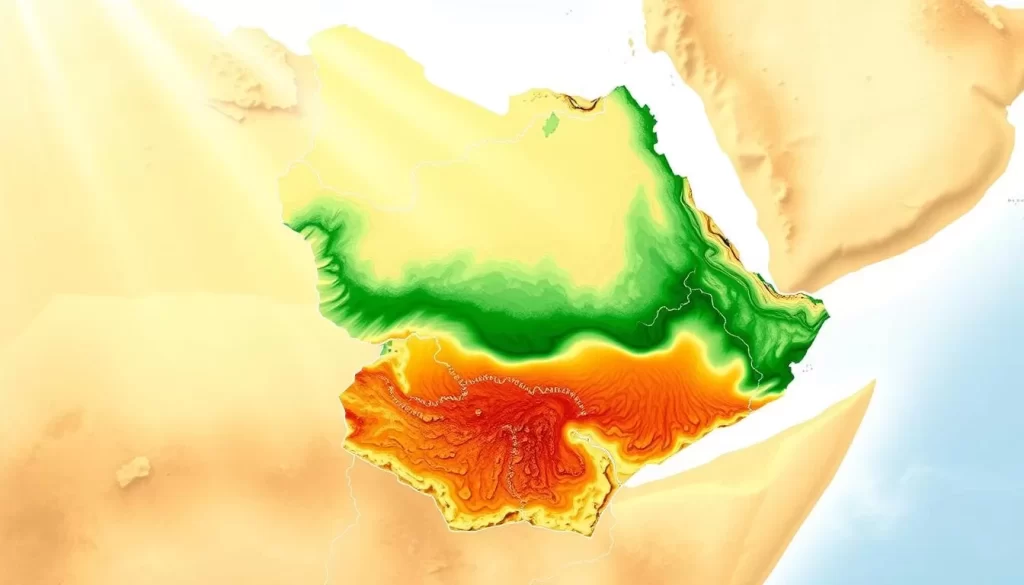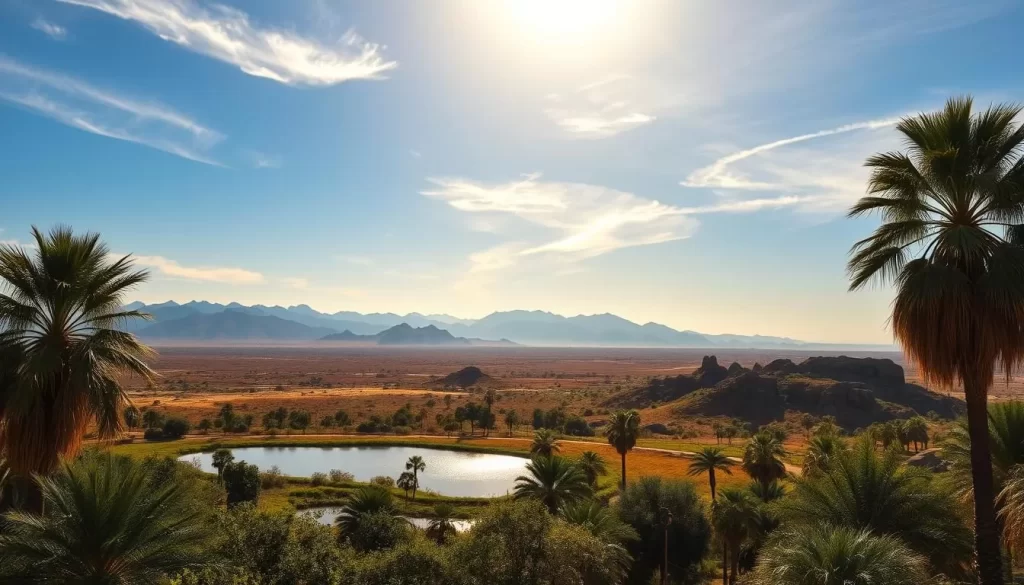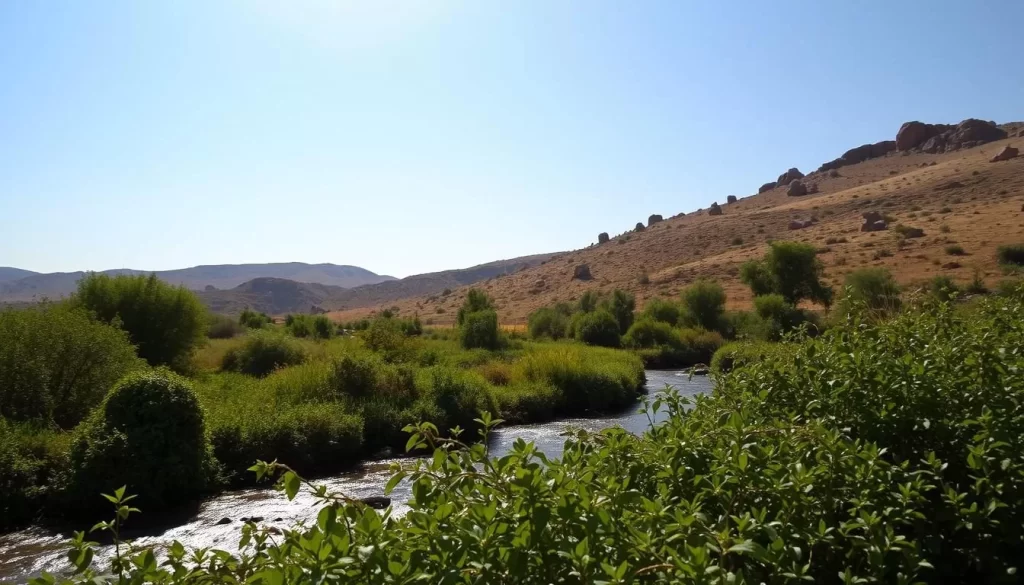✓ Accommodations✓ Flights✓ Rental Cars
Planning a trip to Sudan can be a thrilling experience, but it’s crucial to understand the country’s unique climate patterns to make the most of your travel experience.
Sudan offers a rich cultural heritage, with historical sites and desert landscapes that are worth exploring. However, the extreme weather conditions can significantly impact your journey.
Knowing when to visit Sudan can be the difference between an uncomfortable experience and a rewarding adventure. This guide will help you identify the optimal time for your trip based on weather patterns and regional variations.
By understanding Sudan’s climate, you’ll be able to pack accordingly, plan suitable activities, and maximize your time in this fascinating North African nation.
Understanding Sudan’s Climate Patterns
Located south of the Tropic of Cancer, Sudan’s climate is characterized by extreme variations between its northern and southern regions. The country’s diverse geography plays a significant role in shaping its climate, with the desert climate dominating the north and semi-arid conditions prevailing in the south.
Desert Climate in the North
The northern part of Sudan features a classic desert climate, with scorching days and cool nights. This region experiences minimal rainfall and is prone to frequent dust storms, significantly impacting visibility and travel. The desert climate is harsh, with temperatures often soaring during the day.
Semi-Arid Conditions in the South
In contrast, the southern region of Sudan has semi-arid conditions, influenced by the summer monsoon. This area receives more rainfall than the north, with precipitation exceeding 700 mm (27.5 in) in the far south. The semi-arid climate supports more vegetation and is crucial for the region’s agricultural activities.
Seasonal Temperature Variations
Sudan’s climate is marked by significant seasonal temperature variations. The country’s position south of the Tropic of Cancer results in intense heat throughout much of the year, with temperatures regularly exceeding 40°C (104°F) during summer months. Understanding these variations is essential for planning visits and activities.
| Region | Climate Type | Annual Rainfall |
|---|---|---|
| North | Desert | Minimal |
| South | Semi-Arid | Exceeds 700 mm |
| Central | Transition Zone | Slightly over 100 mm |

By understanding Sudan’s climate patterns, you can better plan your trip, taking advantage of the best weather conditions for your activities. Whether you’re exploring the desert landscapes of the north or experiencing the semi-arid conditions of the south, being aware of the climate will enhance your travel experience.
Sudan: Best Months for a Weather-Savvy Trip
Understanding Sudan’s climate patterns is key to determining the best months for a weather-savvy trip. The country’s diverse climate conditions, ranging from desert to semi-arid, significantly impact the travel experience.
December to February: The Ideal Window
The period from December to February is considered the ideal window for visiting Sudan. During these winter months, daytime temperatures average around 30°C (86°F), while nighttime temperatures can drop significantly, especially in desert regions.
Comfortable temperatures make it an excellent time for exploration and outdoor activities. Whether you’re interested in archaeological exploration, desert adventures, or cultural experiences, this period offers the most favorable conditions.

November: Early Season Benefits
November is another excellent month to visit Sudan, offering early season benefits with gradually cooling temperatures and fewer tourists. This makes it an ideal choice for those who prefer a quieter travel experience.
The dry season, which spans from November to February, provides clear skies and minimal rainfall, creating optimal conditions for visiting archaeological sites and desert landscapes.
Months to Avoid (May-September)
The months between May and September are generally considered the worst time to visit Sudan due to extreme heat, often exceeding 40°C (104°F), and occasional dust storms. Rainfall during this period can make transportation difficult, especially in the southern regions.
Tour companies tend to avoid these times, as transport can become very challenging. If you’re planning to visit Sudan, it’s best to avoid this period for a more enjoyable experience.
Month-by-Month Weather Guide
Understanding the monthly weather patterns in Sudan is crucial for planning a comfortable and enjoyable trip. Sudan’s climate varies significantly across different regions, and being aware of these variations can help you make the most of your visit.
January: Perfect Exploration Weather
January is an ideal time to visit Sudan, with pleasant temperatures ranging from 20-30°C (68-86°F), making it perfect for exploring ancient historical sites and diverse landscapes without the discomfort of extreme heat.
February: Birdwatching and Historical Sites
February continues the favorable weather conditions, with the added attraction of migratory birds from Europe and Asia, making it an excellent time for birdwatching along the Nile and in Sudan’s diverse ecosystems.

March-April: Rising Temperatures
As March and April progress, temperatures gradually rise, reaching uncomfortable levels by late April. However, mornings and evenings remain pleasant for exploring ancient sites and cultural attractions.
May-September: Extreme Heat and Rain
The period from May to September brings extreme heat with temperatures often exceeding 40°C (104°F), accompanied by occasional dust storms in the north and rainfall in the south, complicating travel plans and outdoor activities.
October-December: Return to Pleasant Conditions
From October onwards, Sudan experiences a return to more pleasant weather conditions. While midday heat can still be significant, November and December offer increasingly comfortable conditions with pleasant days and cool nights, making it an excellent time to visit.
- January and February are ideal for general exploration and birdwatching.
- November is best for avoiding crowds at major sites.
- October is great for photography with dramatic cloud formations.
- Understanding the monthly weather patterns allows you to align your visit with your heat tolerance and preferred activities.
By planning your trip according to Sudan’s monthly weather guide, you can ensure a more enjoyable and stress-free experience, making the most of your time in this fascinating country.
Planning Your Activities Around Sudan’s Weather
To maximize your travel experience in Sudan, planning your activities around the country’s weather patterns is essential. Sudan’s climate varies significantly across different regions, making it crucial to tailor your itinerary according to the weather conditions.
Archaeological Sites and Desert Explorations
Exploring Sudan’s archaeological sites, such as the pyramids of Meroe and the temples of Naqa, is best done during the early morning or late afternoon to avoid intense sun exposure, even during the cooler months. Desert explorations, including trips to the Western Desert or Bayuda Desert, are more comfortable during the winter months (November-February) when daytime temperatures are manageable.

Cultural Experiences and Festivals
Sudan’s cultural experiences, such as visiting Nubian villages or attending traditional ceremonies, can be enjoyed year-round. However, the cooler months allow for more comfortable walking and extended outdoor activities. The annual Sufi festival in Omdurman, featuring whirling dervishes, is a highlight during the winter months when outdoor ceremonies are more comfortable for visitors.
Wildlife Viewing Opportunities
For nature enthusiasts, January is an excellent time to explore Sudan’s national parks and wildlife reserves. The cooler temperatures make it easier to spot a variety of wildlife, from desert-adapted species in the north to migratory birds along the Nile River. Wildlife viewing opportunities are best during the cooler months when animals are more active and visible.
When planning your trip, consider building flexibility into your itinerary to adjust activities based on daily weather conditions, particularly if traveling during shoulder seasons. This will ensure that you make the most out of your travel experience in Sudan.
Weather-Smart Travel Tips for Sudan
To ensure a smooth and enjoyable trip to Sudan, follow these weather-smart travel tips. When traveling to Sudan, it’s essential to pack strategically for its desert climate. Bring lightweight, loose-fitting clothing for daytime, and layers for cooler desert nights. Don’t forget a wide-brimmed hat, high-SPF sunscreen, and a scarf to protect against dust and sun.
Hydration is crucial in Sudan’s arid climate. Carry more water than you think you’ll need, and consider electrolyte supplements to avoid dehydration. Be mindful of local cultural norms in your dress and behavior, respecting the country’s rich history and traditions. Plan your daily activities around the weather, starting early in the mornings and taking a midday rest during peak heat hours.
Whether you’re visiting in December or during the shoulder months, book your accommodations in advance. Travel with a reputable guide to navigate historical sites and manage weather-related challenges. With these tips, you’ll be well-prepared for an unforgettable adventure in Sudan.
The above is subject to change.
Check back often to TRAVEL.COM for the latest travel tips and deals.






